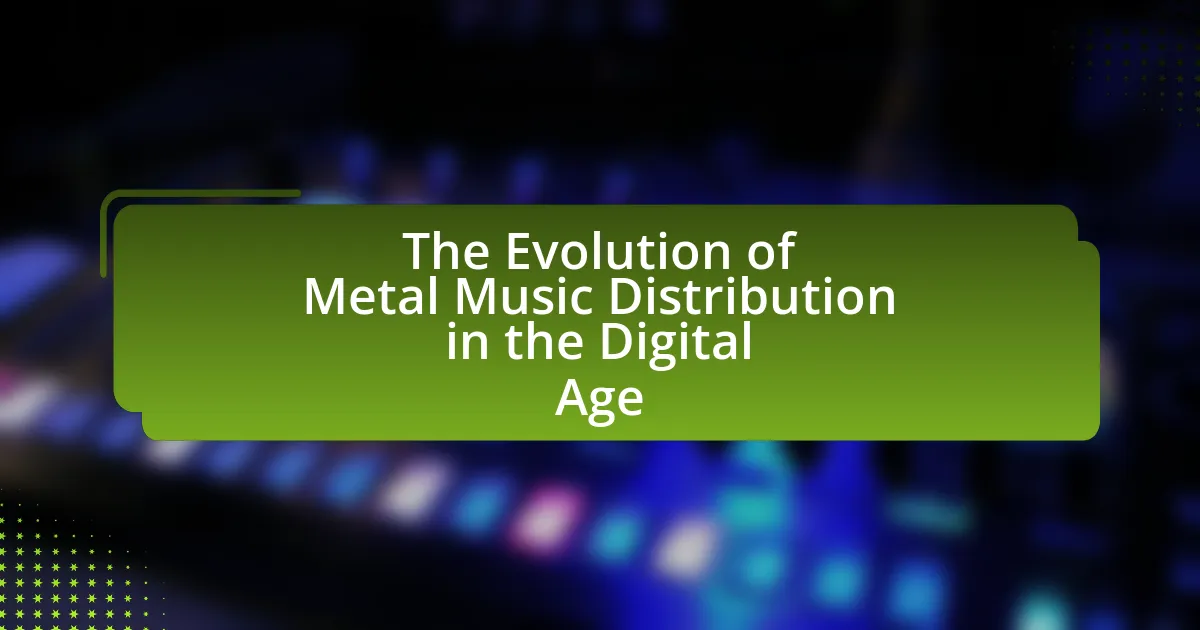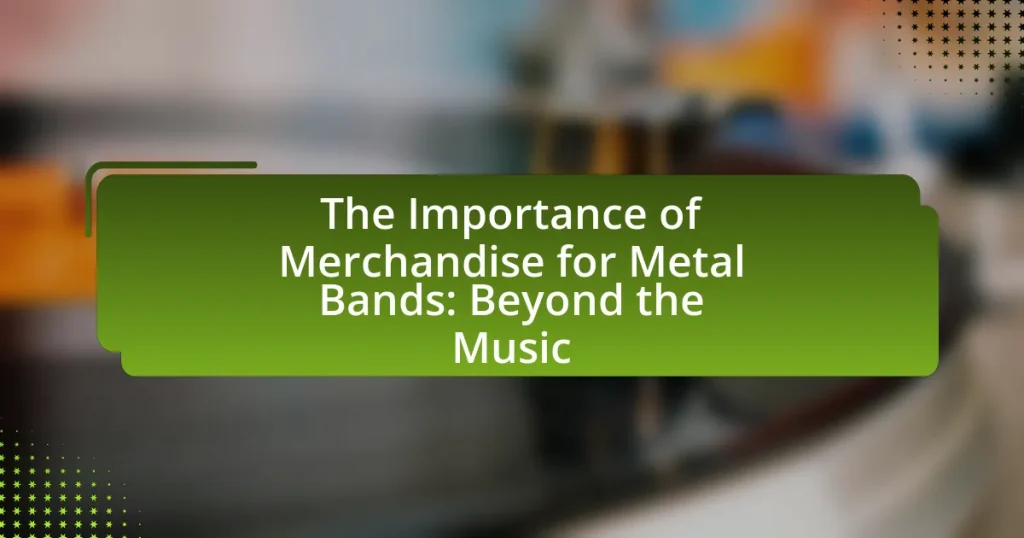The article examines the evolution of metal music distribution in the digital age, highlighting the transition from physical formats like vinyl and CDs to digital platforms such as streaming services and social media. It discusses the impact of the internet on music accessibility, the rise of platforms like Spotify and Bandcamp, and the challenges faced by metal artists in a saturated market. Additionally, the article explores strategies for effective distribution and marketing, emphasizing the importance of engaging with online communities and leveraging technology for better reach and revenue. Key trends shaping the future of metal music distribution, including blockchain technology and direct-to-fan sales, are also addressed.
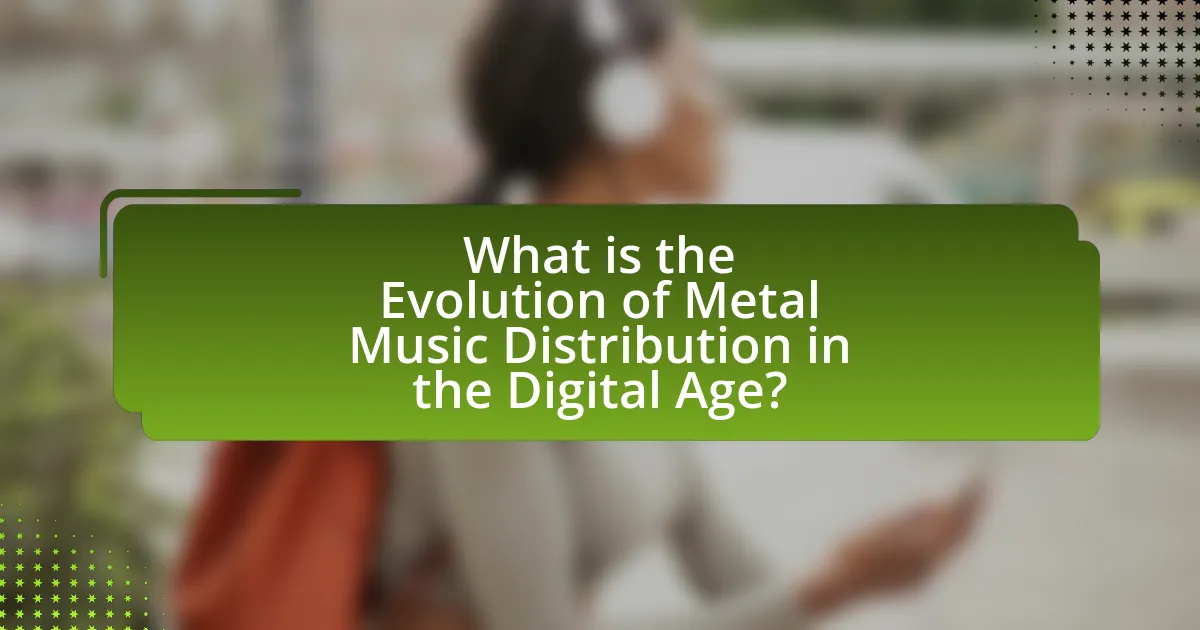
What is the Evolution of Metal Music Distribution in the Digital Age?
The evolution of metal music distribution in the digital age has transitioned from physical formats to digital platforms, significantly altering how fans access and consume music. Initially, metal music was primarily distributed through vinyl records, cassettes, and CDs, which required physical production and distribution channels. With the advent of the internet in the late 1990s, platforms like Napster revolutionized music sharing, allowing fans to download tracks for free, albeit often illegally.
As digital technology advanced, legal streaming services such as Spotify and Apple Music emerged, providing artists with new revenue streams while offering listeners convenient access to vast libraries of music. According to the Recording Industry Association of America (RIAA), streaming accounted for 83% of the U.S. music industry’s revenue in 2020, highlighting the shift in distribution methods. Additionally, social media platforms like YouTube and Bandcamp have enabled metal bands to reach global audiences directly, bypassing traditional record labels. This democratization of distribution has empowered independent artists, allowing them to release music without the need for major label support.
Overall, the digital age has transformed metal music distribution, making it more accessible and diverse while reshaping the industry’s economic landscape.
How has the distribution of metal music changed over the years?
The distribution of metal music has shifted significantly from physical formats to digital platforms over the years. In the 1980s and 1990s, metal music was primarily distributed through vinyl records, cassette tapes, and CDs, with sales driven by physical retail outlets. The advent of the internet in the late 1990s and early 2000s introduced digital downloads and file-sharing services, which disrupted traditional sales models. By the 2010s, streaming services like Spotify and Apple Music became dominant, allowing for instant access to vast catalogs of metal music, which increased accessibility and audience reach. According to the Recording Industry Association of America (RIAA), streaming accounted for over 80% of music industry revenue by 2020, illustrating the profound impact of digital distribution on metal music’s availability and consumption patterns.
What were the traditional methods of metal music distribution?
Traditional methods of metal music distribution included physical formats such as vinyl records, cassette tapes, and compact discs. These formats were sold through record stores, concerts, and mail-order services, allowing fans to purchase music directly. Additionally, radio airplay and music videos on television played significant roles in promoting metal bands and their albums, helping to reach wider audiences. The reliance on these physical and broadcast methods was prevalent before the rise of digital distribution platforms, which transformed how music is consumed and shared.
How did the rise of the internet impact metal music distribution?
The rise of the internet significantly transformed metal music distribution by enabling direct access to music for fans and artists alike. This shift allowed metal bands to bypass traditional record labels, facilitating self-publishing and independent distribution through platforms like Bandcamp and SoundCloud. As a result, artists could reach global audiences without the constraints of physical media or geographical limitations, leading to increased exposure and fan engagement. According to a 2019 report by the International Federation of the Phonographic Industry, digital music revenues, including streaming, accounted for over 56% of the global music market, highlighting the internet’s role in reshaping how metal music is consumed and distributed.
Why is understanding this evolution important for metal artists?
Understanding the evolution of metal music distribution is crucial for metal artists because it directly impacts their ability to reach audiences and monetize their work. As digital platforms have transformed how music is consumed, artists must adapt their strategies to leverage streaming services, social media, and online marketing effectively. For instance, according to a 2021 report by the International Federation of the Phonographic Industry, streaming accounted for 62% of global recorded music revenue, highlighting the necessity for artists to engage with these platforms to sustain their careers. By comprehending these changes, metal artists can optimize their distribution methods, enhance fan engagement, and ultimately increase their financial viability in a competitive landscape.
What challenges do metal artists face in the digital distribution landscape?
Metal artists face significant challenges in the digital distribution landscape, primarily due to oversaturation and competition. The rise of streaming platforms has led to an influx of new music, making it difficult for individual metal artists to stand out. According to a 2021 report by the International Federation of the Phonographic Industry, over 60,000 new tracks are uploaded to streaming services daily, which dilutes visibility for niche genres like metal. Additionally, metal artists often struggle with monetization, as streaming services typically pay artists a fraction of a cent per stream, making it challenging to generate sustainable income. Furthermore, the genre’s dedicated fanbase may prefer physical formats, complicating the transition to digital sales. These factors collectively hinder the ability of metal artists to effectively reach and monetize their audience in the digital age.
How can artists leverage digital platforms for better reach?
Artists can leverage digital platforms for better reach by utilizing social media, streaming services, and online marketing strategies. Social media platforms like Instagram, Facebook, and TikTok allow artists to engage directly with fans, share content, and promote their music, leading to increased visibility. Streaming services such as Spotify and Apple Music provide access to a global audience, enabling artists to distribute their music widely and gain insights into listener demographics. Additionally, targeted online marketing campaigns, including email newsletters and ads on social media, can effectively reach specific audiences, enhancing engagement and driving traffic to their music. According to a 2021 report by the International Federation of the Phonographic Industry, digital music revenues accounted for 62% of the global recorded music market, highlighting the importance of digital platforms in reaching wider audiences.
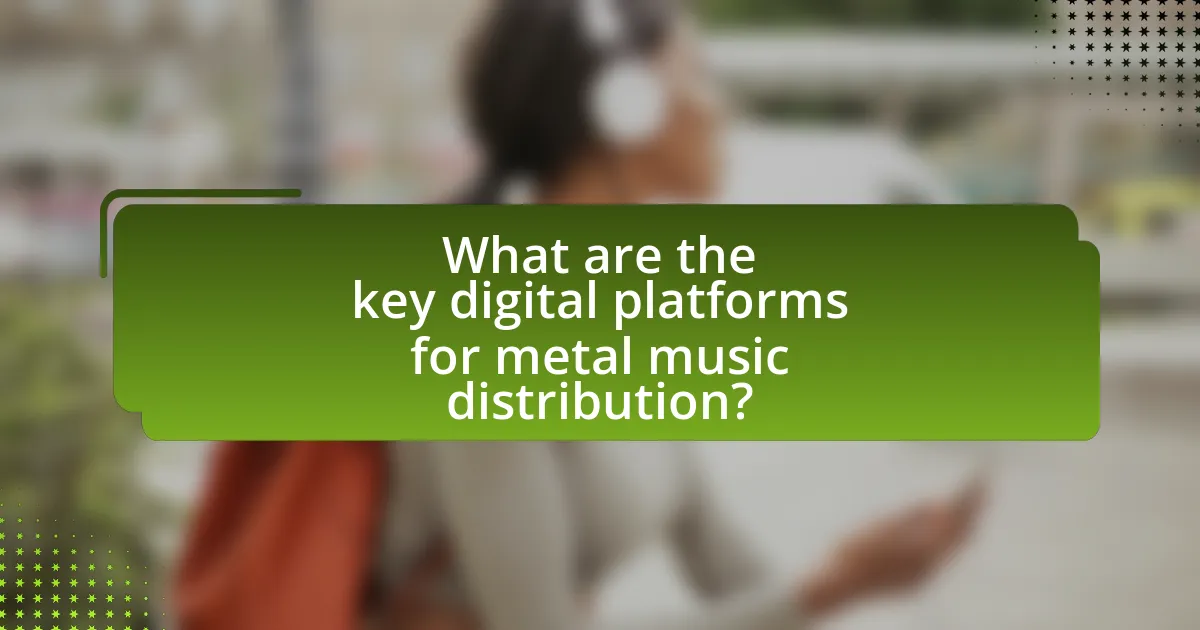
What are the key digital platforms for metal music distribution?
The key digital platforms for metal music distribution include Spotify, Apple Music, Bandcamp, and YouTube. Spotify is one of the largest streaming services globally, with over 400 million users, making it a vital platform for reaching a wide audience. Apple Music, with its extensive library and integration with iTunes, offers another significant avenue for distribution. Bandcamp is particularly important for independent metal artists, allowing them to sell music directly to fans while retaining a larger share of revenue. YouTube serves as a crucial platform for music videos and promotional content, with billions of users engaging with music-related content daily. These platforms collectively shape the landscape of metal music distribution in the digital age.
How do streaming services influence metal music distribution?
Streaming services significantly influence metal music distribution by providing artists with direct access to global audiences and enabling data-driven marketing strategies. These platforms, such as Spotify and Apple Music, allow metal bands to distribute their music without the need for traditional record labels, thus democratizing access to the market. According to a 2021 report by the International Federation of the Phonographic Industry, streaming accounted for 62% of global recorded music revenue, highlighting its dominance in music consumption. Additionally, streaming services offer analytics tools that help artists understand listener demographics and preferences, allowing for targeted promotions and tour planning. This shift has led to increased visibility for niche metal subgenres, which may have struggled to find an audience through conventional distribution methods.
What are the most popular streaming platforms for metal music?
The most popular streaming platforms for metal music are Spotify, Apple Music, and YouTube. Spotify leads the market with over 400 million users, providing extensive playlists and curated content specifically for metal genres. Apple Music, with its vast library and exclusive releases, also caters to metal fans, while YouTube serves as a significant platform for discovering new metal music through official music videos and user-generated content. These platforms collectively dominate the digital distribution landscape for metal music, offering accessibility and a wide range of content for listeners.
How do algorithms affect the visibility of metal music on these platforms?
Algorithms significantly influence the visibility of metal music on digital platforms by determining which content is recommended to users based on their listening habits and preferences. These algorithms analyze user data, such as previous listens, likes, and shares, to curate personalized playlists and suggestions, often favoring genres and artists that align with mainstream trends. Consequently, metal music, which may not always align with popular tastes, can struggle to gain visibility unless it is actively promoted through engagement metrics or playlists specifically targeting metal audiences. For instance, platforms like Spotify utilize algorithms that prioritize tracks with higher streaming numbers, which can disadvantage lesser-known metal bands unless they achieve viral success or significant listener engagement.
What role do social media and online communities play in distribution?
Social media and online communities significantly enhance the distribution of metal music by providing platforms for artists to reach wider audiences directly. These digital spaces facilitate the sharing of music, promotional content, and fan interactions, which can lead to increased visibility and engagement. For instance, platforms like Facebook, Instagram, and Twitter allow musicians to promote new releases and connect with fans, while communities on sites like Reddit or specialized forums enable discussions that can amplify an artist’s reach. According to a 2021 report by the International Federation of the Phonographic Industry, 75% of music consumers discover new music through social media, underscoring the critical role these platforms play in modern distribution strategies.
How can metal artists use social media to promote their music?
Metal artists can use social media to promote their music by actively engaging with fans, sharing content, and leveraging targeted advertising. Engaging with fans through platforms like Instagram, Facebook, and Twitter allows artists to build a community, receive feedback, and create a loyal following. Sharing content such as music videos, behind-the-scenes footage, and live performances increases visibility and keeps fans informed about new releases and events. Additionally, targeted advertising on platforms like Facebook can reach specific demographics, enhancing the chances of attracting new listeners. According to a 2021 report by the International Federation of the Phonographic Industry, social media is a key driver for music discovery, with 70% of users discovering new music through these platforms.
What are the benefits of engaging with online metal communities?
Engaging with online metal communities offers numerous benefits, including enhanced access to music, networking opportunities, and a platform for sharing ideas. These communities provide fans with immediate access to new releases, underground bands, and exclusive content, which is crucial in the fast-paced digital age. Networking within these communities allows musicians to connect with peers, collaborate on projects, and gain exposure to a wider audience. Additionally, members can share insights, reviews, and recommendations, fostering a rich exchange of knowledge and passion for metal music. This collaborative environment not only strengthens individual connections but also contributes to the overall growth and evolution of the metal genre in the digital landscape.
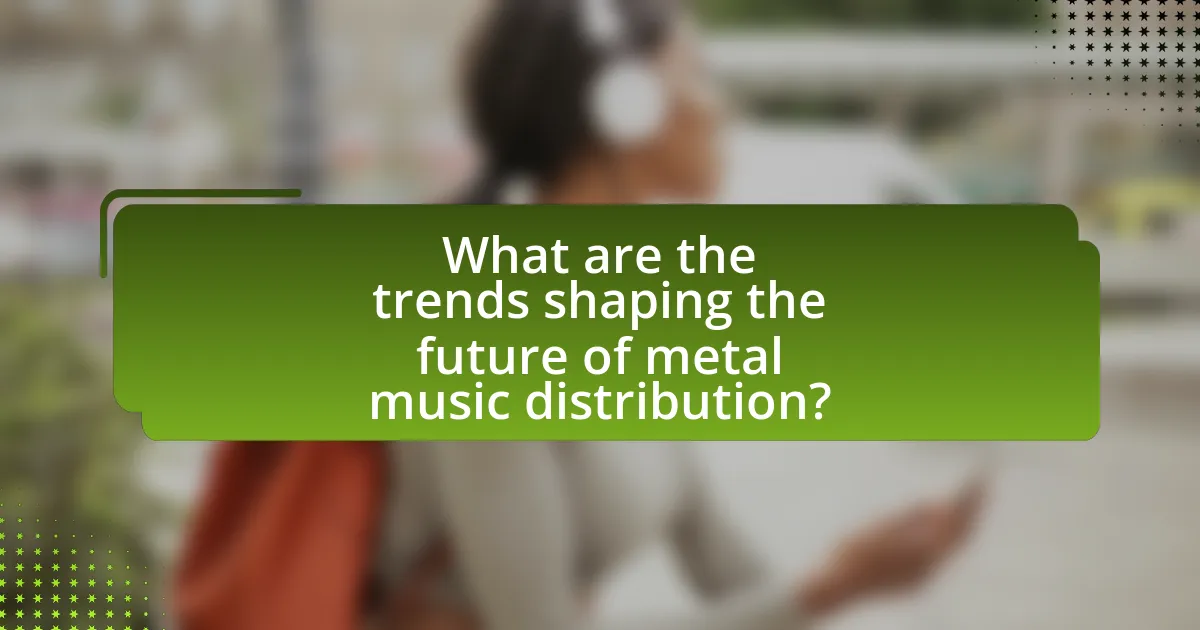
What are the trends shaping the future of metal music distribution?
The trends shaping the future of metal music distribution include the rise of streaming platforms, direct-to-fan sales, and the use of social media for promotion. Streaming services like Spotify and Apple Music dominate music consumption, with over 80% of music revenue in 2022 coming from streaming, according to the Recording Industry Association of America (RIAA). Direct-to-fan sales through platforms like Bandcamp allow artists to retain a larger share of revenue, fostering a closer connection with their audience. Additionally, social media platforms enable metal bands to engage with fans directly, promoting new releases and merchandise effectively. These trends indicate a shift towards more artist-centric models in the distribution of metal music.
How is technology continuing to evolve in music distribution?
Technology is evolving in music distribution through advancements in streaming platforms, blockchain, and artificial intelligence. Streaming services like Spotify and Apple Music dominate the market, providing artists with direct access to global audiences and real-time analytics. Blockchain technology is being explored for its potential to ensure transparent royalty payments and secure ownership rights, as seen in initiatives like Audius. Additionally, artificial intelligence is enhancing music recommendation systems and enabling personalized marketing strategies, which can increase listener engagement and sales. These developments reflect a shift towards more efficient, transparent, and artist-friendly distribution methods in the music industry.
What innovations are emerging in digital music distribution?
Innovations emerging in digital music distribution include blockchain technology, which enhances transparency and ensures fair compensation for artists, and the use of artificial intelligence for personalized music recommendations and automated distribution processes. Blockchain allows for smart contracts that automatically execute payments to artists upon streaming, thereby addressing long-standing issues of revenue distribution. Additionally, AI-driven platforms analyze listener behavior to tailor music suggestions, improving user engagement and satisfaction. These advancements are reshaping how music is distributed and consumed, making the process more efficient and equitable for creators.
How might blockchain technology impact metal music distribution?
Blockchain technology could significantly enhance metal music distribution by providing a decentralized platform for artists to distribute their music directly to fans. This technology allows for transparent tracking of music ownership and sales, ensuring that artists receive fair compensation for their work. For instance, platforms like Audius utilize blockchain to enable artists to upload their music and receive payments in cryptocurrency, bypassing traditional intermediaries. This model not only increases revenue for artists but also fosters a direct relationship with their audience, as fans can support their favorite metal bands without the constraints of traditional record labels.
What strategies can metal artists adopt for successful distribution?
Metal artists can adopt several strategies for successful distribution, including leveraging digital platforms, engaging with fans through social media, and utilizing direct-to-consumer sales. Digital platforms like Spotify and Apple Music allow artists to reach a global audience, while social media channels enable direct interaction with fans, fostering loyalty and community. Direct-to-consumer sales through platforms like Bandcamp empower artists to retain a larger share of revenue and build a more personal connection with their audience. According to a 2021 report by the International Federation of the Phonographic Industry, streaming accounted for 62% of global recorded music revenue, highlighting the importance of digital distribution in today’s music landscape.
How can artists effectively market their music in the digital age?
Artists can effectively market their music in the digital age by leveraging social media platforms, streaming services, and targeted digital advertising. Social media platforms like Instagram, TikTok, and Facebook allow artists to engage directly with fans, share content, and promote new releases, which is crucial as 79% of consumers say user-generated content highly impacts their purchasing decisions. Streaming services such as Spotify and Apple Music provide artists with access to vast audiences and playlist placements, which can significantly increase visibility; for instance, Spotify reported that tracks featured on popular playlists can see a 300% increase in streams. Additionally, targeted digital advertising through platforms like Google Ads and Facebook Ads enables artists to reach specific demographics, enhancing the effectiveness of their marketing efforts.
What are the best practices for maximizing reach and engagement?
To maximize reach and engagement in the context of metal music distribution, artists and labels should focus on leveraging social media platforms, optimizing content for search engines, and collaborating with influencers. Social media platforms like Instagram, Facebook, and TikTok have proven effective for artists to connect with fans, as they allow for direct interaction and sharing of content. According to a 2021 report by Hootsuite, 54% of social media users use these platforms to research products, indicating that engaging content can significantly enhance visibility.
Additionally, optimizing content for search engines through the use of relevant keywords and metadata can improve discoverability. A study by Moz found that 70% of marketers see SEO as more effective than PPC for generating sales, highlighting the importance of organic reach.
Collaborating with influencers in the metal music scene can also amplify reach, as influencers often have established audiences that trust their recommendations. Research from the Digital Marketing Institute shows that influencer marketing can yield an ROI of up to 11 times the initial investment, making it a powerful strategy for engagement.
By implementing these best practices, artists and labels can effectively maximize their reach and engagement in the evolving landscape of metal music distribution.
